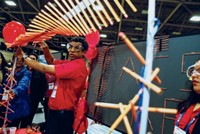Advertisement
Grab your lab coat. Let's get started
Welcome!
Welcome!
Create an account below to get 6 C&EN articles per month, receive newsletters and more - all free.
It seems this is your first time logging in online. Please enter the following information to continue.
As an ACS member you automatically get access to this site. All we need is few more details to create your reading experience.
Not you? Sign in with a different account.
Not you? Sign in with a different account.
ERROR 1
ERROR 1
ERROR 2
ERROR 2
ERROR 2
ERROR 2
ERROR 2
Password and Confirm password must match.
If you have an ACS member number, please enter it here so we can link this account to your membership. (optional)
ERROR 2
ACS values your privacy. By submitting your information, you are gaining access to C&EN and subscribing to our weekly newsletter. We use the information you provide to make your reading experience better, and we will never sell your data to third party members.
Materials
A Material World
Images captured during research turned into award-winning art
by Bethany Halford
December 24, 2007
| A version of this story appeared in
Volume 85, Issue 52
This color-enhanced scanning electron micrograph shows an array of CoFeB nanowires, grown by pulse-current electrodeposition in a nanoporous alumina template. During the electrodeposition process, some of the nanowires overflowed on the template surface. “It’s a reminder that nanoscale research can have unpredicted consequences at a high level,” Béron says.

This color-enhanced scanning electron micrograph shows an array of CoFeB nanowires, grown by pulse-current electrodeposition in a nanoporous alumina template. During the electrodeposition process, some of the nanowires overflowed on the template surface. “It’s a reminder that nanoscale research can have unpredicted consequences at a high level,” Béron says.
In science, images are meant to convey information. Aesthetics are secondary. But sometimes an image is so striking that it transcends its role as data and transforms into art. To recognize those instances when the view through a high-powered microscope is simply stunning, the folks at the Materials Research Society have a "Science as Art" competition.
These Ni-Mn-Ga melt-extracted fibers were imaged with a backscattered electron detector in a field-emission gun scanning electron microscope. The fibers have an approximate diameter of 100 µm and a bamboo-like appearance. “Melt-extraction is a unique and novel method to prepare single-crystalline particles for magnetic shape memory composites,” Gutfleisch explains.

These Ni-Mn-Ga melt-extracted fibers were imaged with a backscattered electron detector in a field-emission gun scanning electron microscope. The fibers have an approximate diameter of 100 µm and a bamboo-like appearance. “Melt-extraction is a unique and novel method to prepare single-crystalline particles for magnetic shape memory composites,” Gutfleisch explains.
The tiny dice in this scanning electron micrograph were made using solder-based, surface tension-driven self-assembly. Leong likens the technique to rudimentary micro-origami, as it allows one to pattern 2D structures and then pop them up into 3D. “One of the big perks of this method is that it allows for easy patterning of the side faces of 3D structures, which is normally very difficult to do,” Leong says. “To highlight this flexibility, we patterned the pips of dice into the faces before folding them.” The result is a collection of gold-coated nickel dice 200 microns wide. The fuzziness of the dice is an accidental result arising from storing the dice in ethanol within polystyrene dishes, Leong notes. “Apparently, the polystyrene slowly dissolved and then formed a partial crust on the dice.”

The tiny dice in this scanning electron micrograph were made using solder-based, surface tension-driven self-assembly. Leong likens the technique to rudimentary micro-origami, as it allows one to pattern 2D structures and then pop them up into 3D. “One of the big perks of this method is that it allows for easy patterning of the side faces of 3D structures, which is normally very difficult to do,” Leong says. “To highlight this flexibility, we patterned the pips of dice into the faces before folding them.” The result is a collection of gold-coated nickel dice 200 microns wide. The fuzziness of the dice is an accidental result arising from storing the dice in ethanol within polystyrene dishes, Leong notes. “Apparently, the polystyrene slowly dissolved and then formed a partial crust on the dice.”
This scanning electron microscope image features a CuInSe2 film with crystalline Cu2Se plates and crystalline InSe needles on its surface.

This scanning electron microscope image features a CuInSe2 film with crystalline Cu2Se plates and crystalline InSe needles on its surface.
The picture shows a colored image of the layered steps formed inside closed pores of La0.8Ca0.2CoO3. The steps were revealed upon fracture of the material, Pathak says.

The picture shows a colored image of the layered steps formed inside closed pores of La0.8Ca0.2CoO3. The steps were revealed upon fracture of the material, Pathak says.
For this picture, two images were taken with a scanning tunneling microscope (STM) and superimposed using Adobe Photoshop. The sky portion is from an image of the organic molecule THAP (tris{2,5-bis(3,5-bis-trifluoromethyl-phenyl)-thieno} [3,4-b,h,n]-1,4,5,8,9,12-hexaazatriphenylene) deposited on Au(111) and subsequently exposed to a high background pressure of cobaltocene. “While THAP on Au(111) is normally very uniform and regularly ordered, exposure to cobaltocene disrupts the order and causes certain molecules to appear much darker in STM,” Ha says. The land portion is a 3D image of a hexaazatrinaphthylene deposited on Au(111). The compound arranges regularly on Au(111), and this appears as the evenly spaced bumps throughout the image. The spikes are clusters of multiple hexaazatrinaphthylene molecules, and the mesas are single atomic layer steps in the Au(111) substrate.

For this picture, two images were taken with a scanning tunneling microscope (STM) and superimposed using Adobe Photoshop. The sky portion is from an image of the organic molecule THAP (tris{2,5-bis(3,5-bis-trifluoromethyl-phenyl)-thieno} [3,4-b,h,n]-1,4,5,8,9,12-hexaazatriphenylene) deposited on Au(111) and subsequently exposed to a high background pressure of cobaltocene. “While THAP on Au(111) is normally very uniform and regularly ordered, exposure to cobaltocene disrupts the order and causes certain molecules to appear much darker in STM,” Ha says. The land portion is a 3D image of a hexaazatrinaphthylene deposited on Au(111). The compound arranges regularly on Au(111), and this appears as the evenly spaced bumps throughout the image. The spikes are clusters of multiple hexaazatrinaphthylene molecules, and the mesas are single atomic layer steps in the Au(111) substrate.
This year's fall meeting, held November 26–30 in Boston, was host to the fourth installment of the popular contest. Of the more than 200 scientists who entered images, 49 were displayed during the meeting for conferees to vote on. Six winners were selected—three garnering first place and three taking second—took home $500 and $300, respectively. The winning images can be downloaded free of charge from the MRS website.
- A Materials Feast In Boston
- Scientists dig in to sessions on unconventional electronics, nanoparticles, and polymers.
- A Material World
- Images captured during research turned into award-winning art.





Join the conversation
Contact the reporter
Submit a Letter to the Editor for publication
Engage with us on Twitter